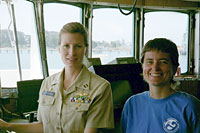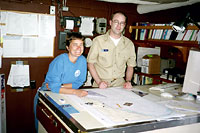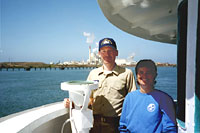

 | |||||||
|
|
Journals 2005/2006Maureen Barrett
August 26, 2005 The weather today was outstanding! The sky was blue, and the average wind speed was under 5 knots. Great conditions to see cetaceans! I spent the morning on the bridge with Captain Alexandra Von Saunder. She gave me a tour of the bridge and explained all the equipment and instruments used on the Jordan. The Captain, or Commanding Officer, is in charge of the safety of the ship, its people, and the equipment. It is the job of Captain Von Saunder to oversee safe navigation on the CSCAPE expedition. On the bridge there is a chart table with hundreds of charts and a computer with electronic chart software. I could see from this equipment that we were over 300 miles west of the Oregon coast! We were at the far west end of the transect line. Our exact location was 44° 42.6' North and 130° 58.8' West. The depth at our location was 2900 meters. Compasses, triangles, and plotters are some of the navigational tools used to plot courses on the charts, and a library of navigational publications are used as well. There are two radars on the bridge. The radar systems detect anything that reflects radio waves. The radio waves are sent out from the ship, hit objects (other ships, land, etc.), and bounce back to the ship. The returning signal indicates the distance of the object from the Jordan. The steering wheel, or helm, while on effort is on automatic pilot. The scientific study dictates that we travel at a speed of 10 knots, which may be close to the top speed of the Jordan. Other pieces of equipment on the bridge include a computerized fire panel, bow thruster control, GPS, and steering repeaters. The ship also has a video system so that the officers have access to views from six different cameras mounted on the ship. Next in charge is Executive Officer Paul Kemp. The XO's main responsibility is for the ship's personnel, disciplinary actions, promotions/demotions, budgeting, expenditures, and injury reports. There are two other officers on board, Field Operations Officer Doug Krause and Navigational Officer Sean Finney. The Field Ops' job focuses on communication with the scientific party on board and with the department heads to make sure all the operations run smoothly. The Navigational Officer is responsible for ordering and updating the charts, putting tracklines on the charts, and all the tools and equipment necessary for safe navigation of the vessel. All of the officers on the Jordan rotate through four-hour watches on the bridge, working four hours on then eight hours off ("a watch in three"). Another key position on the Jordan is held by Jim Anthony. Jim is the Chief Electronics Technician and is responsible for the repair, maintenance, calibration and efficient operation of all the electronic equipment. This includes maintaining the bridge equipment and all the scientific data collection equipment, including the computers we use to send our emails! While on the bridge, a call came over the walkie-talkie from the flying bridge. A whale had been spotted at 30° right. Immediately, the officer in charge responded to the call and changed the course of the Jordan. It was a blue whale and almost immediately we launched the small boat. When the small boat is launched, the rest of the observers on board the Jordan keep an eye on the whale's position and communicate this information to the small boat. But it seemed like something spooked the blue whale. The small boat could not seem to get closer than 100 feet from the whale before the whale sped off. Mammal observer Annie Douglas, who knows a great deal about blue whales, felt it was best to stop the effort to get closer because the whale had picked up speed and was not surfacing it in its traditional way. Maybe there were killer whales in the area, maybe it was a startled response to the small boat, no one knows for sure. A birding highlight for the day was seeing a Red-tailed Tropicbird flying overhead investigating the ship. It is extremely unusual to see this species this far north. All of the observers were pleased with the sighting! |
||||||


